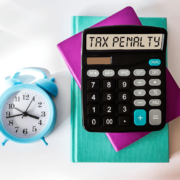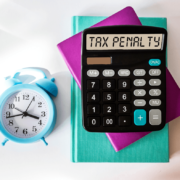SMALL BUSINESS GUIDE
Keep Your Small Business Advantage!
While your know-how is certain to make an important difference in your business’ success, you’re no doubt well aware that producing a winning combination for a smooth-running operation depends on many other factors as well.
High on the list of considerations for your business should be creating the ability to meet criteria imposed by Uncle Sam and the Internal Revenue Service. To help you avoid headaches that can go with trying to meet tax law requirements, this brochure highlights pitfalls to be aware of and provides some tips on how to overcome them.
“Material Participation” In Your Business
“Material participation” has become a major issue for business people since Congress passed rules regarding “passive activities” in the late ‘80s. To show material participation, you as the owner must demonstrate that your activity in your business is continuous and substantial. The IRS has established several “tests” for measuring material participation. An owner who can’t pass any one of the tests will most likely be considered just a passive investor in a company. Since deductible losses from passive activities can be limited to the amount of income from such activities, showing material participation in your business becomes doubly important.
If you work full-time in your business, you will have no trouble showing you materially participate. However, if you’re an employee at another job and operate your business on a part-time basis, you need to make sure you pass one of the material participation tests. One way you can do this is to show that you spend 500 or more hours during the year running your business. You can establish material participation in other ways too – e.g., based on your past years’ involvement or how your work time compares with others working in the business (including employees).
Your Profit Motive
The IRS sometimes questions profit motive of a business owner if an activity consistently shows tax losses. This is common with activities that lend themselves to personal enjoyment or hobby such as horse/dog breeding, arts and crafts, etc. You should be prepared to show that you entered your business with the intent to make a profit and that you are taking measures to realize that intent. How do you show profit motive? At least in part by establishing that you have expertise in your field and you are using businesslike practices in carrying on operations.
Your Recordkeeping Routine:
The recordkeeping system: Give priority to establishing good recordkeeping practices for your business. Recordkeeping goes much farther than actual check writing, depositing income, keeping receipts, etc. Also involved are the choices you must make about accounting methods, dealing with inventory (if any) and other assets, complying with regulatory and tax requirements, and technology. You will probably find taking care of all these details time-consuming and frustrating to say the least; many of the choices you have to make may require help from a financial or accounting professional.
When keeping your business records, though, try to follow a few basic “rules”:
Keep backup for your bank deposits and expenses: Keep bank statements and supporting documents so you can trace your bank deposits, including those that aren’t income (e.g., loan documents for loan proceeds deposited, insurance reimbursement, etc.)
If possible, pay all expenses by check (paper or electronic) or a business credit card. The payments should be supported with sales slips, invoices and any other available documents of explanation. The income and expenses should be recorded in an orderly manner (either by hand or in a software program on a computer) so that the backup can be readily available if and when needed.
Sometimes you can log your expenses in a timely manner so you don’t have to keep receipts. Before you adopt a logging system though, it’s best to check with your tax advisor because the rules for logs are quite strict.
Be sure to keep all reports filed with government agencies: This includes personal income tax returns, sales tax returns, payroll returns, W-2s and 1099s filed for employees and other hired labor, etc.
Length of Time to Keep Records: From a federal tax standpoint (some states may be different), you should retain books and records of your business for three years after the due date of your income tax return. There are some sections of the tax law where the statute of limitations is longer than three years, however. Because of these, it’s wise to keep records at least six years. When it comes to the records that support cost basis of property, equipment or any item that you are depreciating, keep records for at least three years beyond the life shown on the depreciation schedule in your tax return.
Capital Gain Expenses Vs. Other Expenses: Costs of assets that will be used in your business for more than a year and the costs of improvements that add to the value of assets are “capital” expenditures. For tax purposes, these expenses are usually deducted over a number of years. Operating expenses, i.e., advertising, office supplies, etc., are currently deductible, as are the costs of getting started in your business (within limits). Try to keep records for capital expenses separate from those for the general operating expenses.
Expensing Normally Depreciable Costs: Under some circumstances, the costs of depreciable business assets can be deducted all in one year on your tax return (up to a yearly maximum). While this can be a real advantage tax-wise, it also has a negative side – if you dispose of the assets before the end of their normal depreciable life, you may have to “recapture” (i.e., report additional income for) some of the costs you expensed. Be sure to check with your tax advisor before you dispose of assets you previously expensed.
Automobile Expenses: Many business people are uncertain about what car expenses they can deduct. Those expenses you have for traveling between business locations are deductible. However, COMMUTING expenses, i.e., the car costs of going between your home and your office each day, aren’t deductible. But when you travel to TEMPORARY locations away from your regular business location, you can deduct the costs of those trips regardless of the distance. Be sure to keep good records of your business driving by logging for each trip: where you went, your business purpose for going there, who you met with, and the number of business miles you traveled.
You will only be able to deduct expenses for the business portion of your car expense. However, you can choose one of two ways to do this: (1) You can deduct your expenses using actual cost of gas, oil, insurance, repairs, depreciation, etc., or (2) You can multiply your business miles by a standard mileage rate to figure your expense (this rate varies from year-to-year).
Ordinary and Necessary Expenses: The tax law only allows you to deduct expenses that are “ordinary” and “necessary” for your business. Taxpayers and IRS auditors often dispute the meaning of these two terms.
The IRS’ definitions are somewhat general: An “ordinary” expense is one which is common and accepted in your type of business. On the other hand, a “necessary” expense is one that is helpful and appropriate in your business; it does not have to be indispensable.
By doing all you can to make certain that your expenses are ordinary, necessary, not overly lavish and are backed up with a good paper trail, you will have a head start on every year’s tax return!
Other Issues:
Independents vs. Employees: If you hire workers in your business, they will either be classed as independent contractors or employees. The employee-independent contractor issue has been a touchy one between business owners and the IRS for years, so think about this issue carefully when you classify workers. The amount of control you have over the job done determines worker status – the more control you have the more likely it is that a worker is an employee. Then you have to deal with employment taxes, withholding, payroll tax returns and W-2 filing. However, someone who performs services for you should not be classified as an independent contractor just so you can avoid the administrative hassles and costs of treating the individual as an employee; doing so can lead to monetary penalties and cause you and your business serious problems.
A Pension Plan: Maintaining a pension plan offers you an excellent way to defer income from your business and plan for your retirement. One good option is a Keogh plan. Different plans have different rules about contributions, reporting, coverage, etc. Be sure to consult with your plan administrator so that you meet the specific requirements and limitations.
Estimated Tax Payments: If your business is unincorporated, the income you earn from it is reported on your individual tax return and is subject to income and self-employment tax. Since no withholding is usually taken from self-employed income, you may need to pay estimated taxes to avoid getting hit with a penalty. Your tax advisor should be able to help you compute the amount you need to pay to ensure that no penalty is assessed. The usual due dates for estimates are April 15, June 15, September 15, and January 15. However, if a due date falls on a Saturday, Sunday or holiday, the due date will be the next business day.
The advice included in this article is not intended or written by this practitioner to be used, and it cannot be used by a practitioner or taxpayer, for the purpose of avoiding penalties that may be imposed on the practitioner or taxpayer.








Leave a Reply
Want to join the discussion?Feel free to contribute!